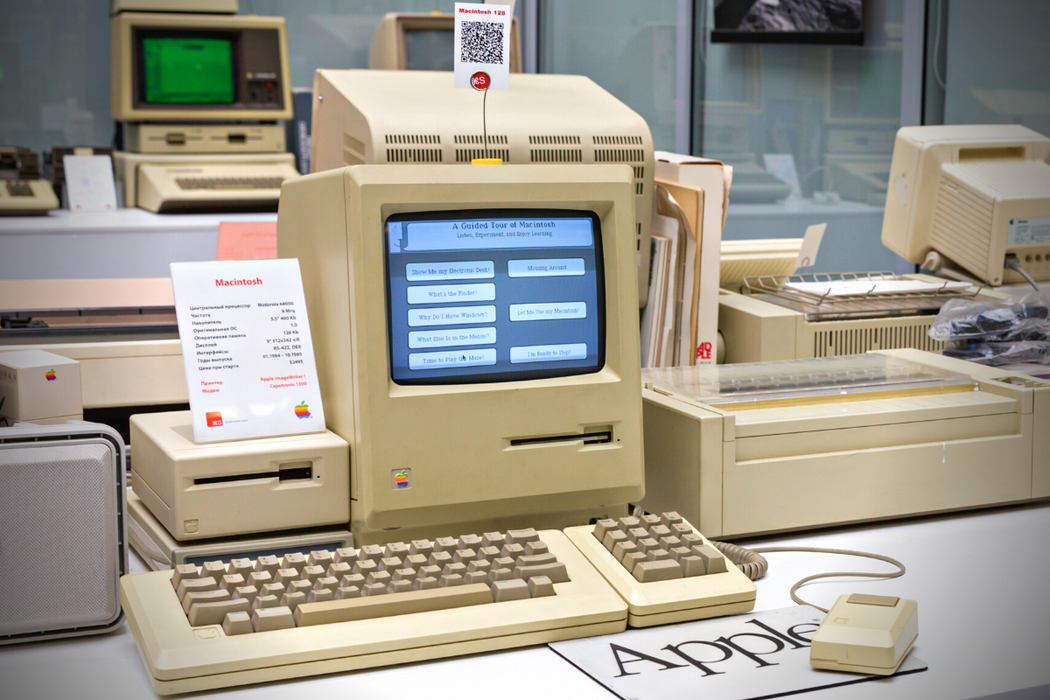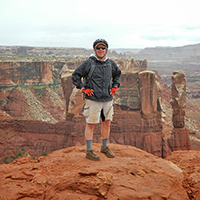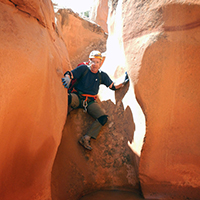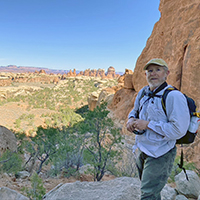UIT’s Dave Huth: Macs ‘fundamentally changed how people interacted with computers’

Even when technology’s good, we know it can be better. Remember the screeching “EEEE-AAAAAHH” of dial-up internet? It was annoying, agonizingly slow, and a modern marvel all at the same time. The problem with predicting the future, particularly when it comes to technology, is we’re “spectacularly bad” at it.
From the personal computer, internet, and mobile devices to artificial intelligence, the past 40 years have brought staggering shifts in new information technology, and Dave Huth has been an insider to these dramatic digital transformations at the University of Utah.

UIT's Dave Huth, left, instructs at the Macintosh teaching lab (MacLab) in 1984.
Huth recently sat down to discuss one watershed moment: The arrival of the first Macintosh computer in 1984.
“Macs became popular very early on because they were more stable and user-friendly than anything else at the time, and easier to support,” he said.
Huth, director for Product Management (CTO Office) & Enterprise Architecture, began as a PC person, then drifted over to Macs for one simple but compelling reason: “Pound for pound, they were better at visualizations than anything else out there.”
“Macs truly stood out as the better operating system for graphics, which is what I needed at work,” Huth said. “They fundamentally changed the way people interacted with computers. You didn't have to enter DOS prompts anymore. Macs were intuitive.”
The Mac OS wasn’t first with a graphical user interface — which combined windowing displays, menus, icons, and a mouse instead of text-based, command-line interfaces — the Xerox Alto's OS did it first. Macs were, however, the first commercially successful GUI personal computer. The first Macs retailed for $2,495, and the U received dozens at a discount, Huth said — not the cheapest personal computer during that era but it was a game-changer in terms of text editing and graphics.
Apple wrote two software programs for the first Mac, Huth explained — MacPaint, which allowed users to draw pictures using a mouse, and MacWrite, a word-processing program. Every Mac also featured AppleTalk, a proprietary networking protocol that made it easy to share files and connect to network devices like printers on a local area network (LAN).
“Macs marked the beginning of a whole new way of doing things,” Huth said.
Huth started out at the U as a statistician in College of Social and Behavioral Science (CSBS).
“Macs became popular very early on because they were more stable and user-friendly than anything else at the time, and easier to support.”
– Dave Huth, director for Product Management (CTO Office) & Enterprise Architecture
“Being a statistician forced you be tech savvy,” he said. “College staff statisticians were the individuals who, through the course of our work, learned to use computers. As faculty began using personal computers, Macs and PCs, statisticians were identified as the people responsible for supporting departmental computers.”
When Macs became readily available, Huth said three U organizations were on the leading edge of computing: the Computer Science Department (now the Kahlert School of Computing); the computer center in the Joseph F. Merrill Engineering Building, where Huth wrote documentation and training; and Administrative Computing Services (ACS), which later reorganized as UIT’s University Support Services.
At the time, Huth said, computer science at the U primarily focused on Unix-based computing like Silicon Graphics International and Sun Microsystems, while ACS’s sole mission was administration. The computer center, he said, provided general compute cycles and featured a lab of terminals for teaching and the general use of a Sperry/Universal Automatic Computer (UNIVAC) mainframe computer.
“The MacLab was added to this shortly before the inception of student computing fees. Once those were in place, college-supported labs popped up all across campus,” Huth said. “Marriott Library was part of the mix and started a large public lab and open-access Mac facility, which made it another IT service-providing organization at the university.”
Like all revolutionary technologies, the Mac was a child with many parents. It existed because of a thousand ancillary developments that seem obvious only in hindsight — the first hard disk in 1956, the first computer mouse in 1964, the first small-scale immersion cooling fan in 1968, and so on. You couldn’t predict Macs without predicting those things, too.
At the U, Marriott Library’s MacLab was the epicenter of learning the ins and outs of the peculiar new device. Well, the outs, anyway.
“You didn’t go and mess around inside a Mac. They weren’t expandable or upgradable. You couldn’t reconfigure them. The ‘out of the box’ nature of the Mac made them quite fool proof,” Huth said.
At CSBS, Huth became known as “the computer guy” and was chosen to network Macs for the college. He split his time between IT support at the college and teaching at the MacLab, , where he imparted everything he knew about the machines to faculty and students.
“Although I have a minor in computer science, that education had little to do with supporting personal computers. PC and Mac magazines, hands-on experience, and working with peers were my primary sources of learning,” he said. “There was a tight connection between departmental computer support areas back then — often actively helping one another with cabling projects, large scale upgrades, and software purchases.”

A university student uses a MacBook Air, one of the mobile successors of the original Macintosh computer. Image courtesy of the University of Utah.
In the decades since the advent of the Mac, Huth has served as associate director for the Center for High Performance Computing, where he led an information security group for the university. Huth’s ad-hoc group became known as the university IT security response team. “We built a small ad hoc team with campus-wide representation and were quite effective,” he said. “This grew over time into what we know now as the Information Security Office.”
When Chief Information Officer Steve Hess was hired as associate vice president for information technology in 2000, he created the Office of Information Technology, and asked Huth to join a team of three — Hess, Huth, and the late Kevin Taylor — as an IT security expert. Huth went on to become interim director for Network and Communications Infrastructure before his role again shifted to IT architecture, project management, and identity and access management. After a stint as an enterprise data architect, Huth headed up product management for the Chief Technology Officer organization and IT enterprise architecture.
For someone whose career hinged on staying on top of IT trends, Huth is somewhat reluctant to adopt technology for technology’s sake.
“I sometimes question technological advances these days — at least the speed of them — or people adopting or acting on them before figuring out how to avoid issues,” he said. “New technology, which isn’t in itself bad, isn’t always rolled out in the most thoughtful way.”
If anything, Huth feels most at home in the great outdoors, disconnected from technology. “Technology is where I earned my livelihood, but it has never been a hobby,” he said.
I guess you can take the hunter/explorer out of Wisconsin, but you can’t take Wisconsin out of the man. The Green Bay native enjoys outdoor activities of all kinds — from wilderness camping to canyoneering to running rivers and mountain biking. He never misses a chance to fish and regularly totes around a pair of binoculars for spotting birds.
“I do seek solitude with my family, which by my definition includes being unplugged from internet and cellular,” Huth said. “When in the wild, I prefer to use paper maps for route-finding, utilizing GPS or digital maps only when necessary.”
He’s also never personally owned a Mac.
“I guess you could say I’m pretty good at keeping my professional and private life separate,” he said.
Below are some photos of Huth out and about:
Node 4
Our monthly newsletter includes news from UIT and other campus/ University of Utah Health IT organizations, features about UIT employees, IT governance news, and various announcements and updates.







